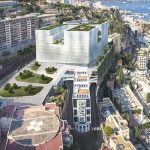Temperatures are rising across the globe. However, few European countries are feeling the heat as much as Spain. More than a fifth of the mainland is desertified, with much of this being the result of human activity. Almost 75% of the rest of Spain’s mainland remains at high-risk. Fortunately, the Spanish government isn’t taking the fight against climate change lightly, with many green energy initatives already announced. One of the more interesting ways that the country is bracing itself for an eco-friendly future is its innovative approach to architecture. For anyone considering a future in architectural design, online Spanish courses are a sound investment. Below, we explore some of the finest examples of Spanish architecture that put eco-friendliness and sustainability at the forefront.
Solar-Powered Lighting at the Glòries Tower
Although the Glòries Tower is one of the newest additions to Barcelona’s skyline, it’s certainly one of the most environmentally friendly. While it was Jean Nouvel, a French architect, who led the design of this building, it’s a testament to Spain’s commitment to a sustainable future. Construction began in 1999, long before the climate urgency was the driving force behind architectural plans. However, its eco-friendly credentials put many newer buildings to shame. This 38-story tower boasts an extensive array of photovoltaic panels that provide all the power needed for the iconic lighting facade of the building. In fact, the Glòries Tower has become a central part of Barcelona festivities, with the facade regularly coming into its own once the sun sets on the Catalonian capital.
Advanced HVAC Systems at Blood and Tissue Bank of Catalonia
This building wins points on every count. For starters, it’s located in 22@, a bustling center of urban renewal that has turned a previously unused industrial site into a hive of technological innovation. This building makes significant savings on energy consumption, with advanced free-cooling HVAC systems as standard. In recent years, the premises has been able to reduce its energy consumption by as much as 70%, just from thermal cooling technology. Not bad when you consider that Catalonia has been bearing the brunt of record-high temperatures recently.
A Holistic Approach To Architecture at the Ecourban Barcelona
The Ecourban Barcelona is a real showcase of environmentally friendly design. Although work was completed on this complex back in 2005, its sustainable credentials are still standard apart from more contemporary buildings. Sustainability informs every single aspect of design here. Recyclable components were used in construction, extending the lifespan of the raw materials, even when the building is eventually demolished or repurposed. It also boasts impressive energy savings. The solar panel array has been precisely oriented to receive as much direct sunlight as possible. Furthermore, a sophisticated array of windbreaks and blinds minimize everyday electricity consumption. Even water demand has been considered here, with rainwater collectors providing a ready supply for everything from cooling systems to cistern tanks. Once filtered, harvested rainwater can even be redirected to drinking supplies and hygiene stations.












